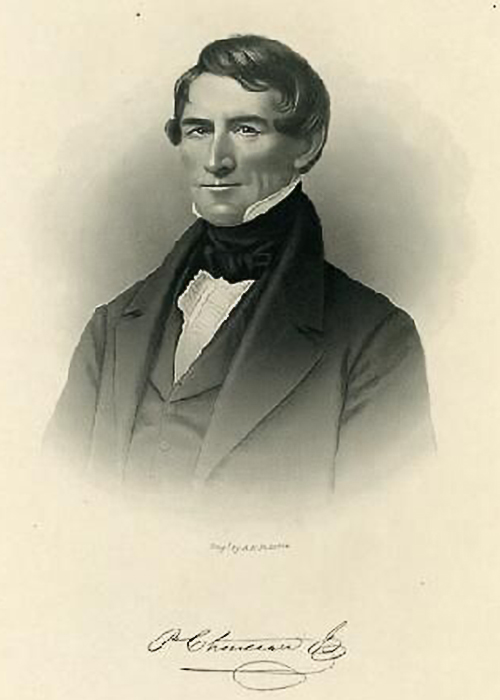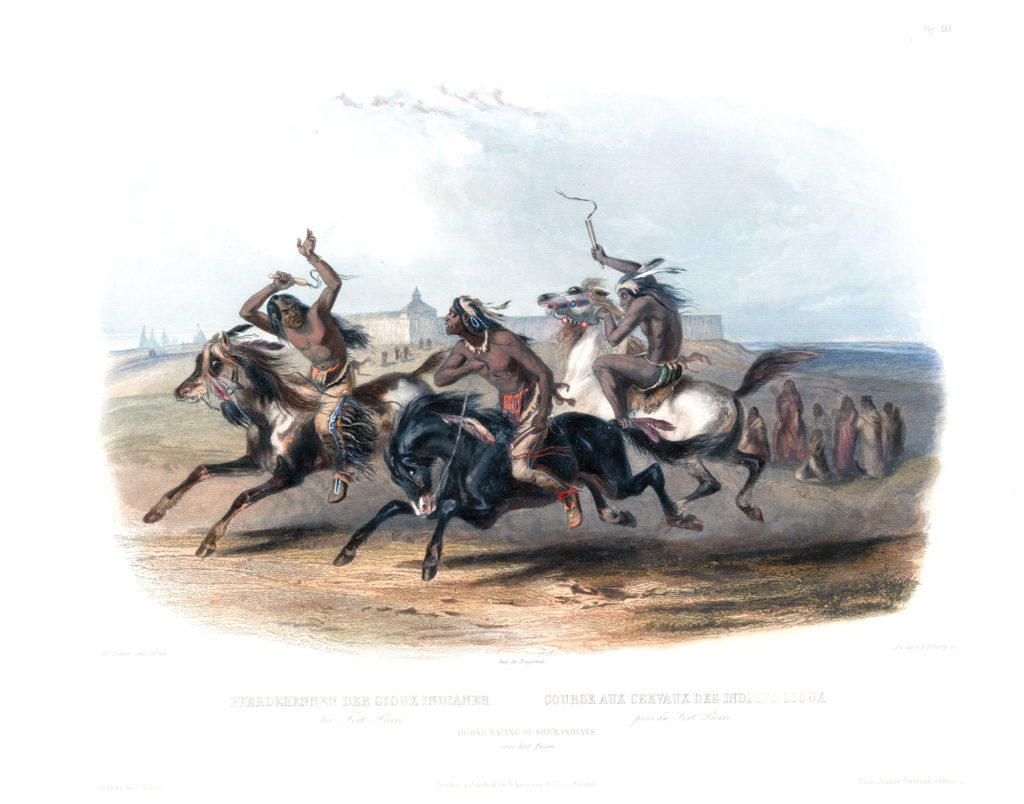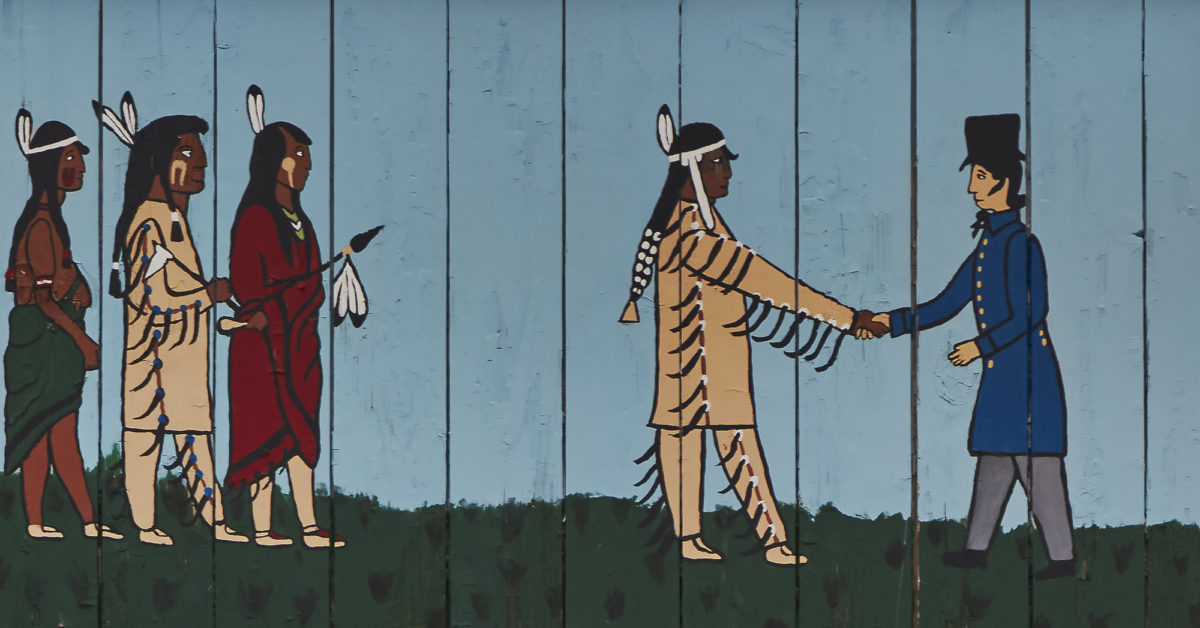The days were short at the American Fur Co.’s Oglala Post that January — the Moon of Frost in the Tepee by the Lakota way of marking time. Trader Thomas L’Estang Sarpy had perched a candle atop the counter for light as he and two assistants put the storeroom in order. One of three brothers in a prominent St. Louis fur-trading family, Sarpy had married into the tribe and was wintering in the post at the confluence of the Cheyenne River and Rapid Creek (near the Black Hills in present-day South Dakota) to barter trade goods for buffalo robes and furs.
Then it happened — perhaps a robe or an elbow bumped the candle, which toppled from the counter into the trade goods stacked below. For Sarpy the world ended with a roar that day, Jan. 19, 1832. In a blinding flash the log building erupted around him as he hurtled through the air to land on the winter earth horribly bruised, burnt and barely alive. He died a short while later, groaning bewildered comments in his native French. His more fortunate assistants survived the explosion. Days would pass before the outside world learned what had happened.
GET HISTORY’S GREATEST TALES—RIGHT IN YOUR INBOX
Subscribe to our HistoryNet Now! newsletter for the best of the past, delivered every Monday and Thursday.
Sarpy in Sioux Country

Sarpy had spent scarcely two years in Sioux country before his fatal accident. Family lore has it his father, Grégoire Sarpy, had banished the young man north because he had been living a wayward existence in St. Louis. In quick succession the young exile married two Lakota wives. “His first wife when he got up there was a daughter [Woman Ahead of the Clouds] of Chief One Ghost [other sources say White Swan] of the Minneconjou band of the Sioux,” Sarpy’s great-great-grandson Clarence Mortenson said in a 2016 interview. “She died in childbirth, leaving a little girl. So he then married the one who was my great-great-grandmother—Her Good Ground, the daughter of [Rotten Body or Stinking Ribs] of the Sans Arc band of the Sioux — and she was the one that raised those two girls [one from each marriage],” Mortenson said. Her Good Ground’s daughter, known to the Lakotas as Wasicu Win (White Woman), went by the Christian name Mary Sarpy.
By marrying the daughter of a chief, a trader could secure good relations with his wife’s band. But Sarpy’s time with Her Good Ground and the Lakotas was cut short by that toppled candlestick on January 19. Eight days later at Fort Tecumseh, American Fur’s post little more than 100 miles east on the Missouri River, clerk Jacob Halsey received word of the accident. The clerk kept a journal of his life on the Plains, and in it that day he wrote that messengers “arrived from the Ogallallahs’ [sic] post with the melancholy news of the death of Mr. Thomas L. Sarpy, the cos. trader at that station.”
Halsey held a comparable position within the company and had known Sarpy well. In his journal he waxed spiritual about the late trader:
Cut off in the prime of life, he has arrived at his eternal home and is fixed in an unchangeable state. Man giveth up the ghost, and where is he, what has become of him who but a short time ago we saw and conversed with? He has gone to the bar of God, to give an account of the time, the means and advantages he has enjoyed and to receive his doom. Mr. S. was one of the cos. most useful clerks. His loss will be felt and much regretted by his employers.
‘Sarpy was found lying on his back some distance from where the building stood. He lived about an hour after the explosion took place and his spirit fled into eternity’
American Fur clerk Jacob Halsey
More than a useful clerk, Sarpy was family to principals in the intricate web of owners that comprised the Western fur trade. Within days the traders at Fort Tecumseh had shared the sad news in letters — at least seven borne by couriers between January 31 and February 22. The first was Halsey’s summary of the tragic events for Pierre “Cadet” Chouteau Jr., the St. Louis businessman who controlled the Western Department of American Fur.
More Details
Chouteau’s prominence can’t be overstated. A year later, when the company replaced Fort Tecumseh with a new trading post, the principals named it Fort Pierre Chouteau in his honor. It is a testament to the power and influence of American Fur itself that Fort Pierre grew into what today is South Dakota’s oldest continuously occupied white community. The city celebrated its bicentennial in 2017, tracing its origins to fur trader Joseph La Framboise Jr., who in 1817 had established an earlier post at the confluence of the Bad River and the Missouri.
In his January 31 letter Halsey told Chouteau that William Laidlaw, the Scottish bourgeois (chief trader) at Fort Tecumseh, had just left for the Oglala Post to put things in order after the accident. “Mr. Sarpy was found lying on his back some distance from where the building stood,” Halsey added. “He lived about an hour after the explosion took place and his spirit fled into eternity. The other two were much injured, but they are now considered out of danger.”
More details emerged later, including the comforting fact Sarpy may have lived only minutes, not a full hour. Trader Honoré Picotte, also writing from Fort Tecumseh on January 31, told Jean Pierre Cabanné, a trader at a post serving the Otoes in eastern Nebraska, that Sarpy was found a considerable distance from where the building stood. The mortally wounded man spoke three times before he died, marveling about the tragedy, asking responders to pour water on his body, then asking them for water to drink.

TOPPLED CANDLE
On February 15, having returned from his visit to the Oglala Post, bourgeois Laidlaw wrote to Kenneth MacKenzie, the company’s principal trader at Fort Union (on the present-day border of North Dakota and Montana). Laidlaw told MacKenzie the toppled candle had landed in a 50-pound keg of powder that had been opened that morning. “It blew three houses all in a line to shivers,” he added. “It is singular that the men who were alongside of him should have escaped without injury, save one that got one side of [him] a little scorched.”
A week later Laidlaw replied to a request from trader Pierre D. Papin for a lock of Sarpy’s hair by which to remember him. “Your letter arrived too late,” Laidlaw wrote, “and even had it been in time before he was interred, it would have been impossible to have got it, as the hair was completely burnt off his head, and [he was] so shockingly disfigured as scarcely to bear any resemblance to a human being.”
One thing that stood out in the aftermath of Sarpy’s death was the superb efficiency of the Oglala warrior society. As Laidlaw related in a February 15 letter to trader David D. Mitchell, there had been no looting of the storehouse ruins, thanks to the warriors. “The conduct of the Indians upon the occasion cannot be too much applauded,” he wrote. “The soldiers [Oglala camp police] mounted guard and collected the goods in every direction and would not allow man, woman or child to approach the fatal spot. Not even a dog was allowed to approach with impunity.”
‘The conduct of the Indians upon the occasion cannot be too much applauded. The soldiers [Oglala camp police] mounted guard and collected the goods in every direction and would not allow man, woman or child to approach the fatal spot’
Fort Tecumseh bourgeois William Laidlaw
Following Up
Laidlaw, in a follow-up letter to MacKenzie, noted the Oglalas delivered the collected goods to a company trader doing business with the Cheyennes (close allies of the Lakotas) some 15 miles away, but not before securing assurances the Cheyennes would not get the trade items they had salvaged. “The former are very tenacious of their rights…[and] insisted upon having the goods that were intended for them,” Laidlaw wrote. “Their conduct has been so meritorious that I could not help humoring them.”
It wouldn’t be the last time whites would have cause to marvel at the Oglalas. Though little known at the time, even to the fur company employees with whom they traded, they would gain the rapt attention of the U.S. Army in coming decades. After all, they were the band of Chief Red Cloud, who would win his 1868–68 war against the United States. They were also the band of Crazy Horse, who in 1876 would lead the combined force that destroyed Lt. Col. George Armstrong Custer’s 7th U.S. Cavalry command at the Little Bighorn.
But all of that remained decades in the future. In 1832 the Oglalas were only an obscure band of Sioux, illuminated for just a moment by candlelight and a flash of powder that destroyed Thomas Sarpy of the American Fur Co. WW
historynet magazines
Our 9 best-selling history titles feature in-depth storytelling and iconic imagery to engage and inform on the people, the wars, and the events that shaped America and the world.






